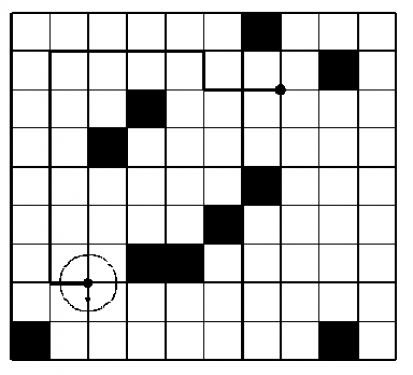题目大意:
一个网格,机器人只能走格点,不能走框内,而障碍物是在框内的,机器人有五个指令:向前走一步、向前走两步、向前走三步、向左转、向右转,每个指令都需要花费1秒中的时间,计算机器人从起点到终点花费的最少时间(原题链接:P1126 机器人搬重物)
如图(图片来自洛谷):

输入格式:
第一行:(N),(M)表示图大小,接下来(N)行就是图,(0)表示空地,(1)表示障碍物,接下来一行起点(x),(y),终点(xx),(yy),初始方向(dir)(一个大写字母):东(E),南(S),西(W),北(N)
输出格式:
一个整数,表示机器人完成任务所需的最少时间。如果无法到达,输出(−1)。
输入:
9 10
0 0 0 0 0 0 1 0 0 0
0 0 0 0 0 0 0 0 1 0
0 0 0 1 0 0 0 0 0 0
0 0 1 0 0 0 0 0 0 0
0 0 0 0 0 0 1 0 0 0
0 0 0 0 0 1 0 0 0 0
0 0 0 1 1 0 0 0 0 0
0 0 0 0 0 0 0 0 0 0
1 0 0 0 0 0 0 0 1 0
7 2 2 7 S
输出:
12
思路:
第一个问题:机器人只能走格点,而障碍物在框内,换句话说就是障碍物的四个顶点机器人都是不可以走的,因此我们可以干脆把原来的图转化成格点图(这个我在做的时候是想到了的。。。)。
转化这个操作在草稿纸上模拟一下就懂了,于是就有了下边的代码。
if(g[i][j] == 1) //转化
{
mp[i-1][j-1] = 1;
mp[i-1][j] = 1;
mp[i][j-1] = 1;
mp[i][j] = 1;
}
再引用一个图吧~~(来自洛谷题解),

转化后了,就相当于这样。
(BFS)还是挺好写的,这图难就难在方向处理,太蛋疼了,看了那位仁兄的题解才懂的。
大的想法:先枚举四个方向,然后再枚举走1~3步,要注意的是我们切换方向的时候也需要用最短的时间来切换,于是我们就用一个数组来存从当前方向转向到最优方向花的时间,代码如下:
mindi[5] = {0, 1, 2, 1, 0}
再再引用一个图吧~~,比如我们在正北方向,那么转到最优方向的时间如下(题目中我们默认它顺时针转动,不过逆时针也可以啦):

再就是转向问题了(用(i)枚举四个方向):用(fdi)数组存方向,用(ffdi)存转动i后的方向。
int fdi[5] = {0, 1, 4, 2, 3}
ffdi[5] = {0, 1, 3, 4, 2}
相关代码:
int ffx = ffdi[t.di] + i; //顺时针旋转i次后后到达的方向编号
if(ffx == 5) ffx = 1;
else if(ffx == 6) ffx = 2;
else if(ffx == 7) ffx = 3;
else if(ffx == 8) ffx = 4;
ffx = fdi[ffx];
比如当前在东(E)方向,也就是方向:(4),(ffx = ffdi[t.di] + i = ffdi[4] + 1 = 3), (ffx = fdi[3] = 2),顺时针转一下到方向(2),即南(S)方向。
再枚举1~3步:
类似于(Dijkstra)的判断:(t.res+spin+1 < dist[nx][ny] || dist[nx][ny] == -1 ) && mp[nx][ny] == 0 如果距离更小 或者 没有到达过 并且点可走:更新距离,入队列。
总代码:
#include <iostream>
#include <queue>
#include <cstring>
using namespace std;
const int N = 55, M = 100;
int g[N][N], mp[M][M];
int n, m;
int x, y, xx, yy;
int dist[M][M];
int mindi[5] = {0, 1, 2, 1, 0};
int fdi[5] = {0, 1, 4, 2, 3}, ffdi[5] = {0, 1, 3, 4, 2}; //
int fx[5] = {0, -1, 1, 0, 0}, fy[5] = {0, 0, 0, -1, 1}; //只走x方向 或者只走y方向
int dir; //起点方向
struct node
{
int sx, sy;
int di;
int res;
};
void direction(char *op)
{
switch(*op)
{
case 'N': dir = 1; break;
case 'S': dir = 2; break;
case 'W': dir = 3; break;
case 'E': dir = 4; break;
}
return;
}
void bfs(int x, int y)
{
node start; //起点
start.sx = x, start.sy = y, start.di = dir, start.res = 0;
memset(dist, -1, sizeof dist);
queue<node> q;
q.push(start);
dist[x][y] = 0;
while(q.size())
{
node d;
auto t = q.front();
q.pop();
for(int i = 1; i <= 4; i++)
{
int spin = mindi[i]; //切换方向的最短旋转次数
int ffx = ffdi[t.di] + i; //顺时针旋转i次后后到达的方向编号
if(ffx == 5) ffx = 1;
else if(ffx == 6) ffx = 2;
else if(ffx == 7) ffx = 3;
else if(ffx == 8) ffx = 4;
ffx = fdi[ffx];
for(int j = 1; j <= 3; j++) //走1~3步
{
int nx = t.sx + fx[ffx] * j, ny = t.sy + fy[ffx] * j;
if(nx <= 0 || nx >= n || ny <= 0 || ny >= m || ((nx == x) && (ny == y)) || mp[nx][ny] == 1)
break; //起点或者障碍物或者越界
if((t.res+spin+1 < dist[nx][ny] || dist[nx][ny] == -1 ) && mp[nx][ny] == 0)
{
d.sx = nx, d.sy = ny, d.di = ffx, d.res = t.res + spin + 1;
dist[nx][ny] = d.res;
q.push(d);
}
}
}
}
}
int main()
{
cin >> n >> m;
for(int i = 1; i <= n; i++)
{
for(int j = 1; j <= m; j++)
{
cin >> g[i][j];
if(g[i][j] == 1) //转化
{
mp[i-1][j-1] = 1;
mp[i-1][j] = 1;
mp[i][j-1] = 1;
mp[i][j] = 1;
}
}
}
char op[2];
cin >> x >> y >> xx >> yy >> op;
direction(op);
bfs(x, y);
cout << dist[xx][yy] << endl;
system("pause");
return 0;
}
这道绿题花了两个小时的时间(AC),然后写了一个小时的博客,太菜了,太菜了。。。